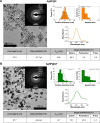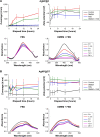Silver nanoparticles: aggregation behavior in biorelevant conditions and its impact on biological activity
- PMID: 30705586
- PMCID: PMC6342213
- DOI: 10.2147/IJN.S185965
Silver nanoparticles: aggregation behavior in biorelevant conditions and its impact on biological activity
Abstract
Purpose: The biomedical applications of silver nanoparticles (AgNPs) are heavily investigated due to their cytotoxic and antimicrobial properties. However, the scientific literature is lacking in data on the aggregation behavior of nanoparticles, especially regarding its impact on biological activity. Therefore, to assess the potential of AgNPs in therapeutic applications, two different AgNP samples were compared under biorelevant conditions.
Methods: Citrate-capped nanosilver was produced by classical chemical reduction and stabilization with sodium citrate (AgNP@C), while green tea extract was used to produce silver nanoparticles in a green synthesis approach (AgNP@GTs). Particle size, morphology, and crystallinity were characterized using transmission electron microscopy. To observe the effects of the most important biorelevant conditions on AgNP colloidal stability, aggregation grade measurements were carried out using UV-Vis spectroscopy and dynamic light scatterig, while MTT assay and a microdilution method were performed to evaluate the effects of aggregation on cytotoxicity and antimicrobial activity in a time-dependent manner.
Results: The aggregation behavior of AgNPs is mostly affected by pH and electrolyte concentration, while the presence of biomolecules can improve particle stability due to the biomolecular corona effect. We demonstrated that high aggregation grade in both AgNP samples attenuated their toxic effect toward living cells. However, AgNP@GT proved less prone to aggregation thus retained a degree of its toxicity.
Conclusion: To our knowledge, this is the first systematic examination regarding AgNP aggregation behavior with simultaneous measurements of its effect on biological activity. We showed that nanoparticle behavior in complex systems can be estimated by simple compounds like sodium chloride and glutamine. Electrostatic stabilization might not be suitable for biomedical AgNP applications, while green synthesis approaches could offer new frontiers to preserve nanoparticle toxicity by enhancing colloidal stability. The importance of properly selected synthesis methods must be emphasized as they profoundly influence colloidal stability, and therefore biological activity.
Keywords: antimicrobial activity; colloidal stability; cytotoxicity; green synthesis.
Conflict of interest statement
Disclosure The authors report no conflicts of interest in this work.
Figures






References
-
- Avnir D. Recent progress in the study of molecularly doped metals. Adv Mater. 2018;30(41) - PubMed
-
- Naor H, Avnir D. Electroless functionalization of silver films by its molecular doping. ACS Appl Mater Interfaces. 2015;7(48):26461–26469. - PubMed
-
- Kühn M, Ivleva NP, Klitzke S, Niessner R. Investigation of coatings of natural organic matter on silver nanoparticles under environmentally relevant conditions by surface-enhanced Raman scattering. Sci Total Env. 2015;535:122–130. - PubMed
-
- Saji VS, Choe HC, Yeung KWK. Nanotechnology in biomedical applications: a review. Int J Nano Biomater. 2010;3(2):119–139.
-
- Thota S, Crans DC. Metal Nanoparticles: Synthesis and Applications in Pharmaceutical Sciences. Weinheim, Germany: WILEY-VCH Verlag; 2018.
MeSH terms
Substances
LinkOut - more resources
Full Text Sources
Miscellaneous

